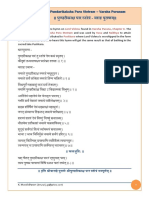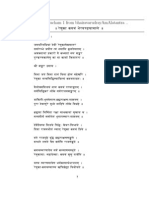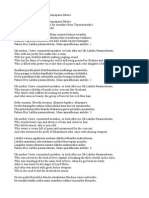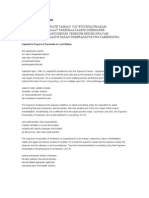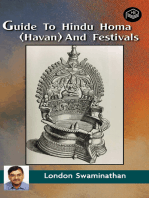0 ratings0% found this document useful (0 votes)
3K viewsVaruna PDF
Varuna PDF
Uploaded by
robertotijoli76hVaruna is a Vedic deity associated with water, the celestial ocean, and the enforcement of cosmic and moral order. As one of the Adityas, he is originally a solar deity but later becomes more closely associated with law, truth, and punishment of wrongdoers. In the Vedas, he is portrayed as all-knowing and able to catch liars in his snares. Later, he becomes the god of oceans and rivers and the keeper of souls of the drowned. He is sometimes compared to Greek Poseidon and Roman Neptune due to his association with water and sea creatures. In the Ramayana, the god Rama performs a penance to persuade Varuna to allow him
Copyright:
© All Rights Reserved
Available Formats
Download as PDF, TXT or read online from Scribd
Varuna PDF
Varuna PDF
Uploaded by
robertotijoli76h0 ratings0% found this document useful (0 votes)
3K views6 pagesVaruna is a Vedic deity associated with water, the celestial ocean, and the enforcement of cosmic and moral order. As one of the Adityas, he is originally a solar deity but later becomes more closely associated with law, truth, and punishment of wrongdoers. In the Vedas, he is portrayed as all-knowing and able to catch liars in his snares. Later, he becomes the god of oceans and rivers and the keeper of souls of the drowned. He is sometimes compared to Greek Poseidon and Roman Neptune due to his association with water and sea creatures. In the Ramayana, the god Rama performs a penance to persuade Varuna to allow him
Original Title
varuna.pdf
Copyright
© © All Rights Reserved
Available Formats
PDF, TXT or read online from Scribd
Share this document
Did you find this document useful?
Is this content inappropriate?
Varuna is a Vedic deity associated with water, the celestial ocean, and the enforcement of cosmic and moral order. As one of the Adityas, he is originally a solar deity but later becomes more closely associated with law, truth, and punishment of wrongdoers. In the Vedas, he is portrayed as all-knowing and able to catch liars in his snares. Later, he becomes the god of oceans and rivers and the keeper of souls of the drowned. He is sometimes compared to Greek Poseidon and Roman Neptune due to his association with water and sea creatures. In the Ramayana, the god Rama performs a penance to persuade Varuna to allow him
Copyright:
© All Rights Reserved
Available Formats
Download as PDF, TXT or read online from Scribd
Download as pdf or txt
0 ratings0% found this document useful (0 votes)
3K views6 pagesVaruna PDF
Varuna PDF
Uploaded by
robertotijoli76hVaruna is a Vedic deity associated with water, the celestial ocean, and the enforcement of cosmic and moral order. As one of the Adityas, he is originally a solar deity but later becomes more closely associated with law, truth, and punishment of wrongdoers. In the Vedas, he is portrayed as all-knowing and able to catch liars in his snares. Later, he becomes the god of oceans and rivers and the keeper of souls of the drowned. He is sometimes compared to Greek Poseidon and Roman Neptune due to his association with water and sea creatures. In the Ramayana, the god Rama performs a penance to persuade Varuna to allow him
Copyright:
© All Rights Reserved
Available Formats
Download as PDF, TXT or read online from Scribd
Download as pdf or txt
You are on page 1of 6
Varuna
From Wikipedia, the free encyclopedia
Varuna
Order (ta), Law and the Ocean
The God Varuna on his mount makara, 1675-1700 Painted in:
India, Rajasthan, Bundi placed in LACMA museum
Devanagari
SanskritTransliteration
Varua
Affiliation Aditya,
Deva,
Guardians of the directions
Abode Celestial ocean (Ras)
Planet Venus
Mantra
O Va Varuya
Nama
Weapon Pasha (Lasso) orVarunastra
Consort Varuni
Mount Makara
In Vedic religion, Varuna (Sanskrit Varua , Malay: Baruna) or Waruna, is a god of
the water and of the celestial ocean, as well as a god of law of the underwater world.
A Makara is his mount. In Hindu mythology, Varuna continued to be considered the god of
all forms of the water element, particularly the oceans.
Contents
1 In the Vedas
2 Similarities with other gods
3 In the Ramayana
4 In Contemporary Hinduism
5 In Zoroastrianism
6 In Modern Age
7 Notes
8 See also
In the Vedas
As chief of the Adityas, Varuna has aspects of a solar deity though, when opposed to Mitra
(Vedic term for Surya), he is rather associated with the night, and Mitra with the daylight. As
the most prominent Deva, however, he is mostly concerned with moral and societal affairs
than being a deification of nature. Together with Mitraoriginally 'agreement' (between
tribes) personifiedbeing master of t, he is the supreme keeper of order and god of
the law. The word t, order, is also translated as "season".
Varuna and Mitra are the gods of the societal affairs including the oath, and are often
twinned Mitra-Varuna (a dvandvacompound). Varuna is also twinned with Indra in the
Rigveda, as Indra-Varuna (when both cooperate at New Year in re-establishing order
[1]
).
The Rigveda and Atharvaveda
[2]
portrays Varuna as omniscient, catching liars in his
snares. The stars are his thousand-eyed spies, watching every movement of men.
In the Rigveda, Indra, chief of the Devas, is about six times more prominent than Varuna,
who is mentioned 341 times. This may misrepresent the actual importance of Varuna in
early Vedic society due to the focus of the Rigveda on fire and Soma ritual, Soma being
closely associated with Indra; Varuna with his omniscience and omnipotence in the affairs
of men has many aspects of a supreme deity. The daily Sandhyavandanam ritual of
a dvija addresses Varuna in this aspect in its evening routine, asking him to forgive all sins,
while Indra receives no mention.
Both Mitra and Varuna are classified as Asuras in the Rigveda (e.g. RV 5.63.3), although
they are also addressed as Devas as well (e.g. RV 7.60.12), possibly indicating the
beginning of the negative connotations carried by Asura in later times.
In post-Vedic texts Varuna became the god of oceans and rivers and keeper of the souls of
the drowned. As such, Varuna is also a god of the dead, and can grantimmortality. He is
attended by the nagas. He is also one of the Guardians of the directions, representing the
west.
Later art depicts Varuna as a lunar deity, as a yellow man wearing golden armor and
holding a noose or lasso made from a snake. He rides the sea creature Makara.
Similarities with other gods
Varuna is often compared to the Greek god Poseidon and the Roman god Neptune as they
are all water deities who ride on celestial sea animals. Varuna rides on theMakara while
Poseidon does so on the Ketos. They both are sometimes depicted as wielding nooses and
tridents, and are both considered an elder brother to the ruling deities in Vedic and Greek
mythology respectively: Indra and Zeus.
[3]
In the Ramayana
Raja Ravi Varma Painting - 'Rama Conquers Varuna'
Faced with the dilemma of how to cross the ocean to Lanka, where his abducted
wife Sita is held captive by the demon kingRavana, Rama (an Avatar of Vishnu) performs a
penance (tapasya) to Varuna, the Lord of Oceans, fasting and meditating in
perfect dhyana for three days and three nights. Varuna does not respond, and Rama arises
on the fourth morning, enraged by the God's arrogance. With his bow and arrow, he angrily
begins attacking the oceans with celestial weaponsburning up the waters and killing its
life and creatures. The Vanaras (Monkeys) are dazzled and fearful at witnessing the
enraged Rama demolish the oceans, and his brother, Lakshmana, prays to calm Rama's
mind. J ust as Rama invokes the brahmastra, considered the most powerful weapon
capable of destroying all creation, Varuna arises out of the oceans. He bows to Rama,
explaining that he himself was at a loss to answer Rama's question. Begging him not to
destroy the oceans with the missile, he suggests that Rama re-direct the weapon at a
demonic race that lives in the heart of the ocean. Rama's arrows destroys the demons, and
establishes a purer, liberated environment there. Varuna promises that he would keep the
oceans still for all of Rama's army to pass, and Nala constructs a bridge (Rama's Bridge)
across to Lanka. Rama justifies his angry assault on the oceans as he followed the correct
process of petitioning and worshipping Varuna, but obtaining the result by force for the
greater good.
[4]
In Contemporary Hinduism
Worship of Varuna is an integral part of the evening ritual of the Sandhyavandanam, of
a dvija Hindu. However, popular worship is primarily limited to Hindus of Sindhi origin.
(See J hulelal)
In Zoroastrianism
"Varun" is one of 101 names of Ahura Mazda, meaning "Deliverer from evil".
Varuna is not attested in the texts of the Avesta. The closest sea deity in Zoroastrian
cosmology is Vourukasha; and the nearest homonym is Varena, the four-cornered
fourteenth region of the world (Vendidad 1.17) and populated by "fiends" and "savage, non-
Aryan natives" (Vd 7.10). In Yasht 15, Haoshyangha begs for a boon that he might smite
"two-thirds of the daevas of Mazana and of the fiends of Varena". (Yt 15.2.6) An individual
who does not follow daena "[the good] religion" is an anya-varena. (Yasna 16.2; Vd 12.21,
15.2)
Too late to be of relevance to a reconstruction of what might have happened to Indo-Iranian
*vouruna (if at all such a predecessor figure existed) in Iran is the "Varuna" of the circa 9th
century texts of Zoroastrian tradition (the so-called "Pahlavi" texts), and in the early New
Persian Shahnameh. In both cases this Varuna is a dim-witted, easily tricked demon of
"backwards"-ness, which is the literal Middle Persian meaning of his name.
Assuming that Vedic Varuna is not a purely Indian development (i.e. assuming that he
derives from an Indo-Iranian *vouruna), there are several different theories on what might
have happened to Indo-Iranian *vouruna in Iran:
Nyberg (Die Religionen des alten Iran, 1938:282ff) sees Varuna represented as
the Amesha Spenta Asha Vahishta "Best Righteousness", an opinionwith extensions
that Dumezil (Tarpeia 1947:33-113) and Widengren (Die Religionen Irans, 1965:12-13)
also follow. This theory is based on Vedic Varuna's role as the principal protector ofrta,
which in Iran is represented by asha [vahishta].
Kuiper (IIJ I, 1957) proposes that none less than Ahura Mazda is a development from an
earlier dvandva *vouruna-mitra. The basis of Kuiper's proposal is that the equivalent of
Avestan mazda "wisdom" is Vedic medhira, described in Rigveda 8.6.10 as the "(revealed)
insight into the cosmic order" that Varuna grants his devotees. In Kuiper's view, Ahura
Mazda is then a compound divinity in which the propitious characteristics of *mitra negate
the unfavorable qualities of *vouruna.
Zimmer (Mnchner Studien 1984:187-215) observed that Varuna has the byname (cult
epithet) bhaga, an adjective that also appears in the Avesta (as baga). It may then be that
the Avestan adjective is likewise a cult epithet, the proper name having been forgottena
not uncommon occurrence. This may be seen to be reflected inArtaxerxes III's invocation
of ahuramazda ura mithra baga "Ahura Mazda, Mithra, and the Baga" (Boyce, Acta
Iranica 21, 1981:59-73).
Another epithet of Vedic Varuna is asura, and there may be a remnant of Varuna in
those Gathic passages (generally presumed to have been composed by Zoroaster himself)
refers to the ahuras (plural) without (aside from Ahura Mazda) explicitly naming them.
While Ahura Mazda is uniformly "the mightiest Ahura" (e.g. Yasna 33.11), in the only two
occurrences of the term where the word does not refer to Ahura Mazda, the poet uses the
expression mazdasca ahurano (Yasna 30.9, 31.4). This phrase, generally understood to
mean "the Wise [Mazda] One and the (other) Ahuras", is in "common opinion" (so Boyce
1984:159) recognized as being archaic and in which the other Ahuras
are *mitra and *varouna. Boyce (Mithra the King and Varuna the Master, 2001) sees this
supported by the younger Avestan dvandvah expression mithra ahura berezanta "Mithra
and the High Lord", the latter being unambiguously Ahura Berezainti, "High Lord" Apam
Napat, the third member of the Ahuric triad (Gray,Foundations, 1929:15), and with whose
Indian equivalent (also Apam Napat) Vedic Varuna is closely associated.
In Modern Age
Two ships in the United States Navy have been named USS Varuna for Varuna, the Vedic
god of oceans and rivers and keeper of the souls of the drowned.
The first Varuna was a screw gunboat launched in 1861 and sunk by enemy action in
April 1862.
Varuna, the Indian Neptune, USS Varuna (1861) & USS Varuna (1943)
The second Varuna (AGP-5) was a motorboat tender, commissioned in 1943 and
decommissioned in 1946.
INS Varuna is a sail training vessel of the Indian Navy. Varuna was completed in April 1981
by Alcock-Ashdown in Bhavnagar. It can carry 26 cadets.
The Varuna class of ship of Indian Navy are sail training vessels. They consist of the
following three ships.
INS Varuna
INS Tarangini
INS Sudarshini
Notes
1. FBJ Kuiper, Ancient Idian Cosmopony, Beombay 1983
2. Shaunakiya Atharvaveda 4.16, corresponding to Paippalada 5.32.
3. http://www.gotejas.com/?p=325
4. R. Menon, The Ramayana, pp. 376-81
See also[edit]
Rigvedic deities
Mitra (Vedic)
Adityas
Guardians of the directions
The king and the god
Paravar
Shukra (guru of asuras, demons)
Asura
Ahura Mazda
Venus (astrology)
Venus (mythology)
Lucifer
You might also like
- Sri Maha Lakshmi AshtakamDocument2 pagesSri Maha Lakshmi Ashtakamapi-3796961100% (3)
- Asya Sri Mohini MantrasyaDocument2 pagesAsya Sri Mohini MantrasyaKambhampati Sandilya100% (1)
- kARTIKEYA PRAGYA VIVARDHANAM PDFDocument5 pageskARTIKEYA PRAGYA VIVARDHANAM PDFSharmila JainNo ratings yet
- C04 MiniCase Turkish Kriz ADocument11 pagesC04 MiniCase Turkish Kriz Aamrrashed2009No ratings yet
- The Grand AfroportDocument6 pagesThe Grand AfroportNetoNo ratings yet
- Beeja MantrasDocument26 pagesBeeja MantrasRavi KumarNo ratings yet
- Vamachara: Pashu-Bhâva (Animal) Is Characterized by A VeryDocument3 pagesVamachara: Pashu-Bhâva (Animal) Is Characterized by A VeryAdamLBrinklowNo ratings yet
- Meditations On RudraDocument3 pagesMeditations On RudraKutticad Ramesh100% (2)
- +++mahasudarshana VyuhaDocument2 pages+++mahasudarshana VyuhaAnthony Munoz100% (1)
- Pundarikaksha para Stotram Varaha PuranamDocument1 pagePundarikaksha para Stotram Varaha PuranamHanu RaoNo ratings yet
- Sandhya Van Dan UmDocument28 pagesSandhya Van Dan Umadith24No ratings yet
- Renuka KavachaDocument5 pagesRenuka KavachaRavindra ShindeNo ratings yet
- Devi Vaibhava Ashcharya Ashtottara Shata Divyanama StotramDocument7 pagesDevi Vaibhava Ashcharya Ashtottara Shata Divyanama StotramAnanda NathaNo ratings yet
- Śrī Pratya Girā Ātmarak A Ā MantraDocument8 pagesŚrī Pratya Girā Ātmarak A Ā Mantrasayan biswasNo ratings yet
- Vagvadini BhagwatiDocument1 pageVagvadini Bhagwativishal1510No ratings yet
- Raurava Agama Vdya PadaDocument109 pagesRaurava Agama Vdya Padaaghorishiva100% (2)
- The Eighteen Sakti Peethas and Their PlacesDocument8 pagesThe Eighteen Sakti Peethas and Their Placeskvnlns0% (1)
- Lankakand Durga Puja 1Document3 pagesLankakand Durga Puja 1Semanti ChakrabortyNo ratings yet
- Mantras 3Document1 pageMantras 3Vijay BhaskarNo ratings yet
- Hanuman Homam: Laghu Paddhati (Short Procedure)Document40 pagesHanuman Homam: Laghu Paddhati (Short Procedure)kselvakumaran9917No ratings yet
- Indian Scriptures: Vidya GitaDocument3 pagesIndian Scriptures: Vidya GitaMaheshawanukarNo ratings yet
- Lopamudra The Holy MotherDocument1 pageLopamudra The Holy MotherAdwaita YogiNo ratings yet
- My MantrasDocument19 pagesMy MantrasRahul Kumar100% (1)
- Agni Suktam BriefDocument12 pagesAgni Suktam BriefVidhi Singh100% (1)
- Sarvadevatha GayathriDocument5 pagesSarvadevatha GayathriJayakrishnaraj AJD100% (1)
- Lord Lakshmi Narasimha - Shri Shanishchara-Krita Shri Narasimha StutiDocument5 pagesLord Lakshmi Narasimha - Shri Shanishchara-Krita Shri Narasimha Stutijuan carlosNo ratings yet
- Narasimha Raja Patha StotramDocument4 pagesNarasimha Raja Patha StotramPuducode Rama Iyer RamachanderNo ratings yet
- Vallabhesa Karavalamba DasakamDocument2 pagesVallabhesa Karavalamba DasakamAmritaNo ratings yet
- Sri Lalitha Sahasranamam OverviewDocument2 pagesSri Lalitha Sahasranamam OverviewAditya HridayamNo ratings yet
- Lalitha SahasranamamDocument20 pagesLalitha Sahasranamambhavani_sureshNo ratings yet
- Sri Vadiraja Tirtha's Thirtha Prabandha On Mçüícé Pàaa: Kanchi VaradarajaDocument5 pagesSri Vadiraja Tirtha's Thirtha Prabandha On Mçüícé Pàaa: Kanchi VaradarajaKiran KvkNo ratings yet
- Sri Vasudevananda SaraswathiDocument13 pagesSri Vasudevananda SaraswathiDowlutrao GangaramNo ratings yet
- Parvati-Stotram Sanskrit PDF File8593Document3 pagesParvati-Stotram Sanskrit PDF File8593Deshna ShahNo ratings yet
- Nitya 1Document8 pagesNitya 1basuNo ratings yet
- Bagalamukhi Kavacham Rudrayamale IAST and Devanagari CombinedDocument5 pagesBagalamukhi Kavacham Rudrayamale IAST and Devanagari CombinedRNNo ratings yet
- Mathangi Saptha Swara Keerthanam (Malayalam)Document2 pagesMathangi Saptha Swara Keerthanam (Malayalam)Narayanan MuthuswamyNo ratings yet
- Narasimha Ta Va Da So Hum.: Mantra For The Destruction of Negative Forces and For ProtectionDocument4 pagesNarasimha Ta Va Da So Hum.: Mantra For The Destruction of Negative Forces and For ProtectionHema Sri Singavarapu100% (1)
- Gandharva - The Celestial Lord of AttractionDocument5 pagesGandharva - The Celestial Lord of AttractionHIM1378No ratings yet
- Bai RavaDocument67 pagesBai Ravajoselopezlopez100% (1)
- Indrakshi Sthothram in English ScriptDocument5 pagesIndrakshi Sthothram in English ScriptEmmaarkayNo ratings yet
- Tripura Sundari Aparadha Kshamapana SthavaDocument4 pagesTripura Sundari Aparadha Kshamapana SthavaSathis KumarNo ratings yet
- Kathmandu's Secret - Part 3 - Guhyeshwari Devi - Journey2LightDocument5 pagesKathmandu's Secret - Part 3 - Guhyeshwari Devi - Journey2LightPooja ChandramouliNo ratings yet
- SV PointersDocument4 pagesSV PointersAnonymous lfw4mfCmNo ratings yet
- Adoration of Sri MookambikaDocument6 pagesAdoration of Sri MookambikaK Krishna Rao100% (1)
- Maha Bhairava Can Dog Rag Horak AliDocument1 pageMaha Bhairava Can Dog Rag Horak AliArijoy BhattacharyaNo ratings yet
- Asta DurgaDocument5 pagesAsta DurgaShiankarRayNo ratings yet
- Gajendra MokshamDocument8 pagesGajendra Mokshamchitratr_bala7846100% (1)
- UntitledDocument11 pagesUntitledrameshk01965No ratings yet
- Sri Mahakala Sahasranamam - EnGDocument10 pagesSri Mahakala Sahasranamam - EnGRamaswamy BhattacharNo ratings yet
- Bala StotramDocument2 pagesBala StotramAnonymous VdXFPOvGxNo ratings yet
- Sandilya Samhita PDFDocument152 pagesSandilya Samhita PDFkeshav3kashmiriNo ratings yet
- Balamala MantramDocument1 pageBalamala MantramChandramouli SankaranarayananNo ratings yet
- Mother Kali Symbolic Bali Non Blood Daan PrayersDocument26 pagesMother Kali Symbolic Bali Non Blood Daan PrayersBivak BhattacharjeeNo ratings yet
- Dattatreya UpasanaDocument28 pagesDattatreya UpasanaSourav ChoudhuryNo ratings yet
- Bhavani PDFDocument2 pagesBhavani PDFakshay patriNo ratings yet
- Maheshvara Stuti Kurma Puranam Eng PDFDocument2 pagesMaheshvara Stuti Kurma Puranam Eng PDFakshra7gjNo ratings yet
- Narayana Bali PDFDocument40 pagesNarayana Bali PDFcsn BabuNo ratings yet
- Maa Kamakali-Mula Mantra & KavachamDocument4 pagesMaa Kamakali-Mula Mantra & Kavachamsinghvijayk100% (1)
- Bhairava Dashanama Stotra : Ten Names of Bhairava to Overcome Pain and SufferingFrom EverandBhairava Dashanama Stotra : Ten Names of Bhairava to Overcome Pain and SufferingNo ratings yet
- Bastrop County Judge Paul Pape's Thoughts On The Confederate MonumentsDocument6 pagesBastrop County Judge Paul Pape's Thoughts On The Confederate MonumentsAnonymous Pb39klJNo ratings yet
- EDLP Presentation POBA EditedDocument44 pagesEDLP Presentation POBA EditedAl BanneNo ratings yet
- 4.leadership - Ethics and Values (ISu)Document21 pages4.leadership - Ethics and Values (ISu)Supun RamanayakeNo ratings yet
- EU-IN ToolkitDocument99 pagesEU-IN ToolkitSolidarityWorksNo ratings yet
- 4G Mobile Broadband Evolution Rel-11 Rel 12 and Beyond Feb 2014 - FINAL v2Document211 pages4G Mobile Broadband Evolution Rel-11 Rel 12 and Beyond Feb 2014 - FINAL v2gptsivaNo ratings yet
- EPINOY Chatbot Brochure 20230403Document7 pagesEPINOY Chatbot Brochure 20230403Baby Ruby AbordoNo ratings yet
- Communicating ABB Ability: Abb Abilit Y Manual, 12 March, 2017 HoustonDocument22 pagesCommunicating ABB Ability: Abb Abilit Y Manual, 12 March, 2017 HoustonpeteatkoNo ratings yet
- The SummonerDocument3 pagesThe SummonerMaria Ana NavarroNo ratings yet
- The Moot Problem Nalsar Unhcr Public International Law Moot Court CompetitionDocument19 pagesThe Moot Problem Nalsar Unhcr Public International Law Moot Court CompetitionasdkjadhakjdNo ratings yet
- ĐÁP ÁN 30 CÂU TỪ VỰNG 9 TẶNG HỌC SINH NHÂN NGÀY KHAI GIẢNG NĂM HỌC CÔ LIỄUDocument8 pagesĐÁP ÁN 30 CÂU TỪ VỰNG 9 TẶNG HỌC SINH NHÂN NGÀY KHAI GIẢNG NĂM HỌC CÔ LIỄUQuang Thinh PhungNo ratings yet
- FIN301 Group AssignmentDocument12 pagesFIN301 Group AssignmentRahat KhanNo ratings yet
- Generosa Ammon Puts Mansion Up For SaleDocument2 pagesGenerosa Ammon Puts Mansion Up For SalePatsy StoneNo ratings yet
- Chapter 3 - Planning Your Tax StrategyDocument48 pagesChapter 3 - Planning Your Tax StrategyChetan BuchcheNo ratings yet
- GI Correction Report For Canceling Material DocumentsDocument3 pagesGI Correction Report For Canceling Material DocumentsDwi RNo ratings yet
- North Ocean Shipping Co - LTD CaseDocument18 pagesNorth Ocean Shipping Co - LTD CaseRobinSinglaNo ratings yet
- Name: Richard Alexis Cano GómezDocument2 pagesName: Richard Alexis Cano GómezRichard CanoNo ratings yet
- Sericulture ReportDocument47 pagesSericulture ReportNaveen Kamat100% (1)
- Selection Among AlternativesDocument24 pagesSelection Among AlternativesDave DespabiladerasNo ratings yet
- Challenges of Translating Islamic Religious Items From Arabic Into EnglishDocument19 pagesChallenges of Translating Islamic Religious Items From Arabic Into EnglishSaber Salem100% (3)
- Comprehensive Drug Abuse Prevention and Control Act of 1970Document2 pagesComprehensive Drug Abuse Prevention and Control Act of 1970Bryan AbestaNo ratings yet
- Negotiable Instruments Law Reading AssignmentDocument2 pagesNegotiable Instruments Law Reading AssignmentDanicaNo ratings yet
- The Hon Bill Shorten MPDocument3 pagesThe Hon Bill Shorten MPPolitical AlertNo ratings yet
- Full Course AISDocument121 pagesFull Course AISAHMED ABDALLAHNo ratings yet
- PANIQUI NORTH - Achievement Rate - Q2 SY 2021-2022Document6 pagesPANIQUI NORTH - Achievement Rate - Q2 SY 2021-2022Maestro VarixNo ratings yet
- Energy Conservation Act 2001 and Its FeaturesDocument2 pagesEnergy Conservation Act 2001 and Its FeaturesIftikar HussainNo ratings yet
- Master of Science in International Business Economics and ManagementDocument2 pagesMaster of Science in International Business Economics and ManagementJulesNo ratings yet
- North West DistrictDocument8 pagesNorth West Districttulika dixitNo ratings yet
- KKLUTHRA Respondent kkl03Document26 pagesKKLUTHRA Respondent kkl03suvekshya thapaNo ratings yet









